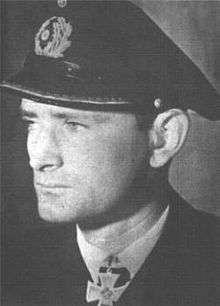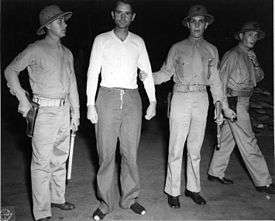Klaus Bargsten
| Klaus Bargsten | |
|---|---|
 Klaus Bargsten | |
| Born |
31 October 1911 Bad Oldesloe |
| Died |
25 October 2000 (aged 88) Bremen |
| Allegiance |
|
| Service/branch |
|
| Years of service | 1936–45 |
| Rank | Kapitänleutnant |
| Unit |
1st U-boat Flotilla 2nd U-boat Flotilla 4th U-boat Flotilla |
| Commands held |
U-563, 27 March 1941 – 15 March 1942 U-521, 3 June 1942 – 2 June 1943 |
| Awards |
U-boat War Badge Knight's Cross |
Klaus Bargsten (31 October 1911 – 25 October 2000) was the captain and sole survivor of sunken U-521. He was also a recipient of the Knight's Cross of the Iron Cross (German: Ritterkreuz des Eisernen Kreuzes). The Knight's Cross of the Iron Cross was awarded to recognise extreme battlefield bravery or successful military leadership.
Biography
Early life
Bargsten was born on 31 October 1911 in Bad Oldesloe. His mother came from an aristocratic family, and his father was of peasant stock. His grandfather had made a fortune in farm machinery and banking. After completing his schooling, Bargsten attended a school for training merchant marine officers and was later employed by North German Lloyd Steamship Co. He served mostly on freighters but was also on the SS Europa for a time. He joined the Nazi party but received such adverse criticism from his family that he later resigned.
In 1935 Bargsten entered the naval academy. As a midshipman, he served for a time on the Admiralty yacht Grille. This ship was frequently used by Adolf Hitler and other Nazi party leaders but, being only a humble midshipman, Bargsten had little contact with them. When the war began, he was serving at the U-Boot-Schule (submarine training school) in Neustadt. After a short time on U-6, he applied to be transferred to U-99.
He was then posted to U-99 under Otto Kretschmer where he served as I. Wachoffizier (1st watch officer) for several patrols. He was a highly capable officer and Kretschmer recommended him for Commander Training and ultimately, for command of his own boat. He left U-99 in January 1941 and in March commissioned U-563 on 27 March 1941 and during battle against convoy HG-75, he sank a freighter, but unsuccessfully attacked a Royal Navy destroyer. On his second patrol he sank the British destroyer HMS Cossack. After the third patrol he left the boat on 15 March 1942 and three months later commissioned U-521 on 3 June 1942.
U-521
On 2 June 1943 the United States submarine chaser PC-565 was 100 nautical miles (190 km) east of Cape Hatteras escorting convoy NG-355 when it picked up a sound contact. They had successfully made contact with U-521. PC-565 set the hydrostatic fuzes on her depth charges to 100 feet (30 m) and a pattern of five charges were dropped in a harassment action.
The accuracy of the depth charges was devastating. Inside U-521, all instruments were shattered, all electrical circuit-breakers blown, and the diving planes and rudder were disabled. Cold seawater was coming down the main hatch. Bargsten gave the order to dive for cover. After a few seconds, Oberleutnant (Ing.) Henning reported that they were sinking. She was already down to 500 feet (150 m) and dropping rapidly. Even though it did not make sense to Bargsten that the U-boat could plummet so quickly, he gave the order to blow all ballast. The main depth gauge must have been knocked out by the depth charges. Before he knew it, the U-boat broke the surface. Bargsten snapped open the conning tower hatch and rushed outside to assess the situation.
PC-565 interception
PC-565 was only a quarter mile away. She opened up with her 20 mm gun. Shells burst on and around the U-boat's conning tower. Realizing that U-521 was done for, Bargsten shouted down the conning tower to open the sea cocks and abandon ship. U-521 sank from under the Captain's feet with amazing speed. The last thing Bargsten saw as he looked down was a maelstrom of water pouring into the open hatch. U-521 was gone and Bargsten was left floating in the ocean alone.
"Some question the situation where Bargsten got out of U-521 just quick enough to see the rest of his crew drowned. The first act of abandonment in a U-boat is to secure the captain, and thus he was the first and last one out of the boat itself. Let it be noted that Bargsten has no acts of cowardice in his military record."
With professional conduct, PC-565 turned as U-521 sank under the surface. PC-565 dropped another depth charge. Huge bubbles of air rose to the surface. Oil and debris littered the surface, followed by large pieces of human remains. Bargsten rose to the surface and struggled swimming towards the nearest Allied ship.
Ray Lankheim, a machine gunner of PC-565, had his 20 mm trained on this lone survivor of the crew as Bargsten was swimming for his life, but could not bring himself to shoot this lone man in the cold water. Instead Bargsten was captured and spent more than three years in Allied captivity before being released in 1946.
Interrogation of Klaus Bargsten

PC-565 had transported Klaus Bargsten to Norfolk, Virginia for questioning. Bargsten told his captors of several accidents that had befallen U-boats, including the sinking of U-43 at the pier in Lorient in January 1941.
Another accident described by Bargsten was the collision of two U-boats in the Baltic Sea in August or September 1942, during their tactical exercises. One boat was commanded by Oberleutnant zur See Ulrich Pietsch of the 1935 naval term. The other U-boat was commanded by an officer named Friedrichs. Bargsten was under the impression that the latter was U-195. (Note: U-195 has been reported as a 1200-ton U-boat. It has not been possible to identify Friedrichs with any certainty. There are three officers of this name in the German Naval List of 1940. Kapitänleutnant Adolf Friedrichs of the October 1937 naval term, has had a post in the coast artillery.)
The rudder of Pietsch’s boat became jammed, the two boats collided, and both were badly damaged. A second accident occurred to Pietsch’ boat during the working up trials. During torpedo firing exercises, while submerged, Pietsch heard propeller noises in an area in which no other ships were supposed to be present. Suddenly his boat was rammed. On surfacing, he discovered that the ship was none other than the Scharnhorst.
Bargsten said that in Danzig he had seen the Baltic Sea freighter, Morgenrot, lying on her side after being rammed by U-512 under command of Kapitänleutnant Wolfgang Schultze.
The prisoner recounted the story of an artillery duel in June 1942 between a destroyer and U-333 commanded by Kapitänleutnant Peter-Erich Cremer. He said that Cremer was so severely wounded that a plane was sent to take him from the U-boat and rush him to a hospital. (Note: This apparently happened in the Bay of Biscay, probably on a patrol subsequent to the one in which he was rammed by a tanker (June 1942) and brought his U-boat to port completely battered.)(Note 2: This story is somewhat different in the book by Peter Cremer, U-Boat Commander)
Bargsten told many anecdotes about his friends and acquaintances in the U-boat Service. His most intimate friend and classmate was Korvettenkapitän Reinhard Suhren. It was stated that Suhren, good looking and popular, could considerably lower the alcoholic stocks of any port in which he found himself. His personality was described as enthusiastic and carefree. Two incidents in which Suhren figured were recounted by Bargsten. On one occasion, Suhren met another U-boat at sea. Suhren and the captain of the other boat were on the bridge as they approached each other. An exchange of greetings and affectionate insults passed across the narrowing gap between the two boats. So immersed were the two captains in conversation that their boats collided, necessitating the return of both U-boats to their base for repairs. Despite his carelessness, Suhren was readily forgiven this peccadillo.
On another occasion, Suhren was stalking a convoy which he had previously reported to the Commander in Chief U-boats. In due course, he received an "inspirational" message from Dönitz telling him to "pursue relentlessly and attack fiercely". Upon returning from this cruise, which was highly successful, Suhren was summoned to the office of Dönitz to give his report. In the course of the interview, Suhren violated decorum by referring to the signal as unnecessary, if not insulting. Dönitz was taken aback for a moment by this impudence but recovered.
In speaking of training and tactics, Bargsten said that the training of prospective U-boat commanders through a "Konfirmandenfahrt" (guest cruise) had been abandoned. He said that captains were now drawn from the ranks of watch officers and that the Agru Front (Active Service Training Group) was considered sufficient additional training.
According to the prisoner, 250-ton U-boats are known as "Einbäume" (dugout canoes).
Bargsten spoke at some length on the St Nazaire Raid of March 1942. He said that the British soldiers, posing as Germans, would approach a sentry and ask: "Kamerad, hast du Feuer?" (Comrade, have you got a light?). When the sentry would reach for a match, he would be attacked. It was stated that officers and crews of U-boats were forbidden to take part in the action, as they could easily have been captured in their white night shirts. They were transported from the danger area in automobiles. One famous U-boat captain, now the commanding officer of a flotilla, made the excuse of having to relieve himself and got out of the car. He later succeeded in returning to the scene of the fight and was wounded in the foot. He was placed under arrest for disobeying orders.
After Bargsten's interrogation he was held in captivity until his release in 1946, the Kriegsmarine falsely reported the entire crew of U-521 as MIA (Missing in Action).
Post World War II
Through extensive research, Klaus Bargsten was found living in Bremen. He was invited to the reunion of PC-565. He accepted and the crew was there to greet him. Needless to say, the reunion was a huge success. Several PC-565 sailors were delighted to reunite with their German companion.
Ranks and Military Decorations
Ranks
The following is a list of dates for Kptlt. Bargsten's promotions during World War II.
| Date | Rank |
|---|---|
| 1 July 1936 | Fähnrich zur See[1] |
| 1 January 1938 | Oberfähnrich zur See[1] |
| 1 April 1938 | Leutnant zur See[1] |
| 1 October 1939 | Oberleutnant zur See[2] |
| 1 August 1942 | Kapitänleutnant[2] |
Decorations
The following is a list of Kptlt. Bargsten's awards and decorations.
| Date | Decoration |
|---|---|
| 23 July 1940 | Iron Cross (1939) 2nd Class[2] |
| 10 August 1940 | U-boat War Badge (1939)[2] |
| 25 September 1940 | Iron Cross (1939) 1st Class[2] |
| 30 April 1943 | Knight's Cross as Kapitänleutnant and commander of U-521[2] |
Commands
The following is a list of Kptlt. Bargsten's commands in the Kriegsmarine navy.
| U-Boat | Command Length |
|---|---|
| U-563 | 27 March 1941 – 15 March 1942, 2 patrols (69 days) |
| U-521 | 3 June 1942 – 2 June 1943, 3 patrols (169 days) |
References
Citations
Bibliography
- Busch, Rainer; Röll, Hans-Joachim (2003). Der U-Boot-Krieg 1939–1945 — Die Ritterkreuzträger der U-Boot-Waffe von September 1939 bis Mai 1945 [The U-Boat War 1939–1945 — The Knight's Cross Bearers of the U-Boat Force from September 1939 to May 1945] (in German). Hamburg, Berlin, Bonn Germany: Verlag E.S. Mittler & Sohn. ISBN 978-3-8132-0515-2.
- Gentile, Gary (1989). Track of the Gray Wolf. Avon Books. ISBN 0-380-75685-4.
External links
- Helgason, Guðmundur. "Klaus Bargsten". German U-boats of WWII - uboat.net. Retrieved 19 April 2014.